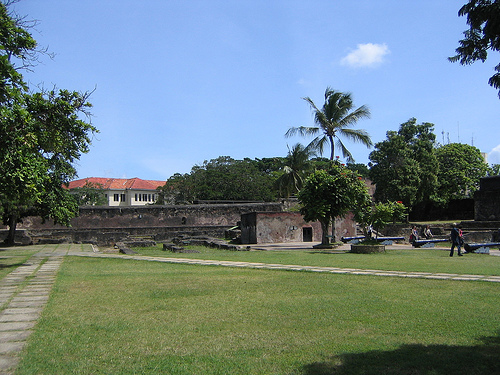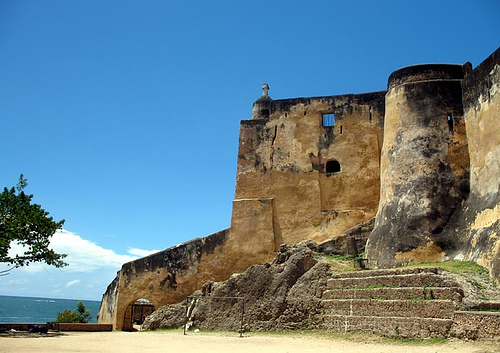

Location: Nkrumak Rd, Mombasa Map
Tel. 041 2225 934
Open: 8am- 6pm daily
Constructed: 1593
Fort Jesus, located in Mombasa, Kenya, is a historic fortress built by the Portuguese between 1593 and 1596 to secure their dominance over the Swahili Coast and protect their trade routes in the Indian Ocean. Designed by Italian architect Giovanni Battista Cairati, it is one of the best-preserved examples of 16th-century Portuguese military architecture in Africa. Its strategic position on Mombasa Island, overlooking the harbor, made it a pivotal stronghold for centuries, changing hands multiple times among Portuguese, Omani Arabs, Swahili rebels, and British forces. Today, it is a UNESCO World Heritage Site (designated in 2011) and a major cultural and tourist attraction managed by the National Museums of Kenya.

The Portuguese, under Vasco da Gama’s explorations in
1498, sought to control the lucrative Indian Ocean trade, which included
spices, gold, ivory, and slaves. Mombasa was a thriving Swahili
city-state, and its harbor was a key stopover. After repeated conflicts
with local rulers, the Portuguese decided to build Fort Jesus to
consolidate their authority. Named after Jesus to reflect the religious
zeal of the era, the fort was constructed using local coral stone and
imported materials, with labor from both Portuguese workers and enslaved
Africans.
The fort’s history is marked by sieges and power
struggles:
1593–1698: Portuguese control, though frequently
challenged by local Swahili and Omani forces.
1696–1698: The longest
siege in the fort’s history, when Omani Arabs blockaded it for 33
months, leading to a Portuguese surrender due to disease and starvation.
1728–1729: A brief Swahili rebellion expelled the Portuguese, but they
regained control.
1741–1895: Omani Arab rule under the Busaidi
dynasty, who used the fort as a military and administrative base.
1895–1963: British colonial administration repurposed it as a prison and
government office.
Post-1963: After Kenya’s independence, it became a
museum and historical site.
Fort Jesus is a quadrangular bastion fort, designed in
the Renaissance-era Italian style, with four main bastions named San
Felipe, San Alberto, San Mateus, and San Antonio. Its layout resembles a
human figure, a symbolic design choice. Key architectural elements
include:
Walls and Bastions: Built from coral stone, the walls
are up to 3 meters thick, with angled bastions allowing overlapping
fields of fire to deter attackers. The seaward walls are higher to
withstand naval assaults.
Moat: A dry moat on the landward side
enhanced defense, though it was never filled with water.
Gun
Emplacements: Cannon ports and embrasures housed artillery, some of
which (like 18th-century cannons) remain on display.
Internal
Structures: The fort contained a barracks, captain’s house, chapel,
cisterns for water storage, and storerooms. The chapel, one of the
oldest European-style buildings in sub-Saharan Africa, still has traces
of its original altar.
Omani Additions: During Omani rule, a
distinctive arched entrance and the “Omani House” (a raised structure
for ventilation) were added, blending Arab architectural elements.
Frescoes and Inscriptions: Wall paintings, including ship sketches and
Christian symbols, survive in some rooms, offering insights into the
fort’s occupants.
The fort’s design prioritized defense, with narrow
passages and elevated positions to repel invaders. Its coral stone
construction, while durable, required constant maintenance due to
erosion from Mombasa’s humid climate.
Fort Jesus is a testament to the multicultural interactions of the
Swahili Coast:
Trade Hub: It protected Mombasa’s role in
Indian Ocean trade, linking Africa, the Middle East, India, and
Europe. Artifacts like Chinese porcelain and Persian pottery found
during excavations highlight these connections.
Colonial Legacy:
The fort symbolizes the impact of European and Arab colonialism on
East Africa, as well as local resistance. It was a site of
oppression, including the slave trade, with dungeons where captives
were held.
Swahili Identity: Despite foreign control, the fort
reflects the Swahili Coast’s cosmopolitan culture, blending African,
Arab, and European influences.
Archaeological excavations have
uncovered artifacts like ceramics, beads, and weapons, now displayed
in the fort’s museum. These findings illuminate daily life, trade,
and warfare during its active years.
Today, Fort Jesus is a National Monument and a flagship site of the
National Museums of Kenya. It houses a museum showcasing artifacts,
historical exhibits, and reconstructions of life in the fort. Key
attractions include:
Guided Tours: Visitors can explore the
battlements, dungeons, and Omani House, with guides explaining the
fort’s history.
Exhibits: Displays include Swahili culture,
Portuguese naval history, and Omani artifacts.
Sound and Light Shows:
Evening multimedia shows recreate historical events like sieges.
Conservation Efforts: Ongoing restoration addresses structural damage
from weathering and past neglect. UNESCO’s designation has spurred
international support for preservation.
The fort hosts cultural
events, such as festivals and exhibitions, celebrating Mombasa’s
heritage. Its scenic location offers panoramic views of the Indian
Ocean, making it a popular spot for photography.
Preservation: Humidity and saltwater erosion threaten the coral stone
structure, requiring costly maintenance.
Urban Encroachment:
Mombasa’s growth has led to nearby development, impacting the fort’s
historical ambiance.
Tourism Management: Balancing visitor access
with conservation is a concern, as foot traffic and environmental
factors strain the site.
Visiting Fort Jesus
Location: Old Town,
Mombasa, accessible by foot, taxi, or tuk-tuk from central Mombasa.
Hours: Open daily, typically 8:00 AM to 6:00 PM.
Entry Fees:
Approximately KES 1,200 (about $12 USD) for non-residents and KES 400
for Kenyan residents, with discounts for children (fees may vary; check
with National Museums of Kenya).
Tips: Wear comfortable shoes for
uneven surfaces, bring water, and consider a guide for a richer
experience. Combine a visit with exploring Mombasa’s Old Town, a
UNESCO-recognized area with Swahili architecture.